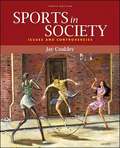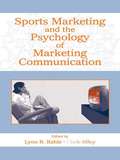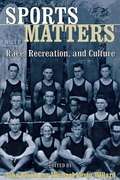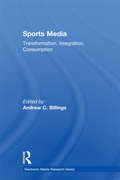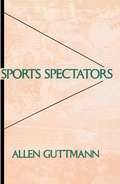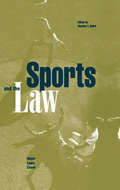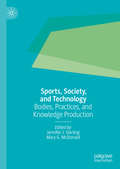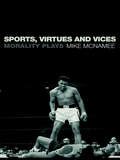- Table View
- List View
Sports In Society: Issues and Controversies
by Jay CoakleySports in Society is the definitive text for the sport sociology course. Taking a global, issues-oriented approach to the study of the role of sport in society, this text encourages the discussion of current sports-related controversies and helps students develop critical thinking skills.
Sports Journalism and Women Athletes: Coverage of Coming Out Stories
by William P. Cassidy“Women’s sports have typically been grossly under-represented in sports media coverage. Although elite lesbian athletes far outnumber ‘out’ male athletes, media scrutiny of their experiences remains largely non-existent. Largely situated in the context of improved cultural attitudes toward sexual minorities across the West, Bill Cassidy’s Sports Journalism and Women Athletes: Coverage of Coming Out Stories is, therefore, a valuable contribution to the study of sports journalism and media, offering – for the first time – a dedicated and detailed account of the coming out of some of sports’ most high-profile lesbian athletes.”- Dr. Rory Magrath, Solent University, UKThis book examines sports journalism coverage of the coming out stories of three prominent women athletes: tennis legend and feminist icon Billie Jean King, Basketball Hall of Fame Member Sheryl Swoopes and WNBA champion Brittney Griner. When King was outed in 1981 it marked a pivotal moment in which journalists were forced to discuss lesbian athletes in sports for the first time. Swoopes’ 2005 coming out was hailed as a historic moment due to her status as one of the best women’s basketball players of all time, while Griner’s casual public acknowledgment of her sexuality came during what many have called a more receptive environment for gay and lesbian athletes. By directly analysing and comparing the media attention given to these three superstars, Cassidy provides a comprehensive overview of how journalists have historically addressed women and lesbian athletes in professional sports. This book will appeal to readers interested in sports journalism, the role of sport in society, and media coverage of gay athletes.
Sports Management in an Uncertain Environment (Sports Economics, Management and Policy #21)
by Michel Desbordes Bhaskar Basu Soumya SarkarThis edited book delves into several aspects of sports and sports management from a vantage of uncertainty and turbulence unleashed initially by COVID-19. The book, divided into three broad sections, deals in strategy and governance of sports organizations, use and evolution of technology in sports, and sports consumption and media. It starts from the backdrop of how sport assumed a new-found importance in people's lives while reeling under several phases of pandemic-induced lockdowns. Consumers felt how integral sports was in their lives when there were no live games to watch and bond on. Players, leagues, organizers, and media are still recovering, along with viewers, as sports makes a tentative comeback in our lives. COVID-19 was a precursor of the disruptions to come. Both the supply and demand sides have taken note of those disturbances to prepare themselves for any such potential derailments. The organizations, franchises, athletes, media, health care, logistics on sports have been reworking their strategies to keep coping with uncertainties. On the other hand, the consumers have transformed their sports consumption behavior over these two years, aided by the enormous technological changes. Such a backdrop paved the way for researchers to understand how the sports industry has dealt with this impact and has rediscovered itself to take its coveted spot. This book is a snapshot of several global sports changes and how they continue to evolve in an increasingly turbulent and uncertain world. It will be a rich resource not only for academics studying sports management, but also event management organizations, administrators, and policymakers.
Sports Marketing and the Psychology of Marketing Communication
by Chris Riley Lynn R. KahleSports marketing is one of the fastest growing areas of marketing communication. This book advances understanding in this emerging area. It presents sports marketing in a scholarly and comprehensive way, covering major topics of discussion in sports marketing and the psychology of communication. Several new, innovative topics are introduced, such as SportNEST and consumption communities, and many classic topics are brought up to date, including sponsorship, ambush marketing, identification, endorsements, basking in reflected glory, and licensing. Many of the topics that seem to center around sports show up as well, such as sneakers, ethics, risky behavior, and even investments. Utilizing a psychological approach to understanding sports marketing, first-rate authors discuss the most important topics. The book covers all major topics of sports marketing, including: sponsorship from several different perspectives--the major force in sports marketing; ambush marketing--how non-sponsors seek to reap the benefits without paying the price; and licensing--using the sale of items, such as T-shirts to increase profit and marketing.
Sports Matters: Race, Recreation, and Culture
by John Bloom Michael Nevin Willard"Most of the contributions strongly project the authors' perceptions of the role of race on their subjects, and essays should elicit lively discussions in the classroom. " --CHOICE Frederick Douglass liked to say of West Indian boxer Peter Jackson that "Peter is doing a great deal with his fists to solve the Negro question. " His comment reflects the possibilities for social transformation that he saw in the emerging modern sports culture. Indeed, as the twentieth century developed, sports have become an important cultural terrain over which various racial groups have contested, defined, and represented their racial, national, and inter-ethnic identities. Sports Matters brings critical attention to the centrality of race within the politics and pleasures of the massive sports culture that developed in the U. S. during the past century and a half. The contributors collected here address such issues as popular representations of blacks in sports. They consider baseball--from Nisei players in Oregon to Mexican-Americans in Los Angeles. And they look at the use of warrior imagery in representations of Native American athletes and the evolution of black expressive style within basketball. Sports Matters challenges our presumptions about sports, illuminating in the process the complexities of race and gender as they relate to popular culture. Contributors include Amy Bass, John Bloom, Annie Gilbert Coleman, Gena Caponi, Montye Fuse, Randy Hanson, Michiko Hase, George Lipsitz, Keith Miller, Sharon O'Brien, Connie Razza, Sam Regalado, Greg Rodriguez, Julio Rodriguez, Michael Willard, and Henry Yu.
Sports Media History: Culture, Technology, Identity (Routledge Research in Sports History)
by John CarvalhoThis research collection explores the ongoing interaction between sports, media, and society throughout important periods in history, from the ninetenth century to the present day. It examines both historical moments and broader trends in sports, with an emphasis on the media’s role. Encompassing a variety of research approaches and perspectives, the book looks at the individuals, mass media outlets and communication technologies that have affected societies on a global scale, including print, photography, broadcast (radio and television), Internet-based media, and public relations/marketing. It presents fascinating new case studies covering topics as diverse as sports journalism and the Third Reich, Argentina at the Mexico World Cup, post-9/11 sports reporting, Martina Navratilova and women’s tennis, the growth of fantasy sport, and the significance of Joe Louis and Jackie Robinson in the history of US sports reporting. This is essential reading for any researcher, student or media professional with an interest in the relationships between sports, culture, and society or in the history of media, culture, or technology.
Sports Media: Transformation, Integration, Consumption (Electronic Media Research Series)
by Andrew C. BillingsLooking toward a future with increasingly hybridized media offerings, Sports Media: Transformation, Integration, Consumption examines sports media scholarship and its role in facilitating understanding of the increasingly complex world of sports media. Acknowledging that consumer demand for sports media content has influenced nearly every major technology innovation of the past several decades, chapters included herein assess existing scholarship while positing important future questions about the role sports media will play in the daily lives of sports fans worldwide. Contributions from well-known scholars are supplemented by work from younger researchers doing new work in this area. Developed for the Broadcast Education Association's Electronic Media Research series, this volume will be required reading for graduate and undergraduate students in media, communication, sociology, marketing, and sports management, and will serve as a valuable reference for future research in sports media.
Sports Medicine, Performance Enhancement and Doping: A Critical History (Routledge Research in Sport, Culture and Society)
by Ivan Waddington Christophe BrissonneauTracing the history of sports medicine from the ancient world through to the present day, this book shines new light on the embedded relationship between physicians, performance enhancement and doping in elite sport.Combining historical and sociological analysis, the book shows how sports medicine, as it developed in the late nineteenth and twentieth centuries, became increasingly disengaged from its origins in preventive medicine to become closely linked with elite level competitive sport. The book demonstrates how this link between sports medicine and elite competitive sport drew sports physicians into the search for enhanced performance so that by the second half of the twentieth century performance enhancement had become an essential raison d’être of sports medicine practitioners. It examines how this search for enhanced performance has often led sports physicians to play a prominent role in the development and provision of performance-enhancing drugs, and looks in depth at the case study of France and professional cycling, scene of some of the most high-profile and consequential doping cases of all time.This book is fascinating reading for anybody with an interest in sport history, the history of medicine, medical ethics, the ethics of sport, sport and society, or science and society.
Sports Mega-Events in Asia (Palgrave Series of Sport in Asia)
by John Horne Jung Woo Lee Younghan Cho Koji KobayashiThis book is the first comprehensive collection focusing on the hosting of sports mega-events within Asia and their impact on the politics, economics, and culture that shape, and are shaped by, the local idiosyncrasies of host cities and countries across this most culturally diverse continent. From the Olympic Games and single sport World Cups, to the Asian Games and their sub-regional variations, an increasing number of Asian countries have rapidly developed their capacity to host and mobilize large-scale sports events as a cornerstone of their economic growth, national identity formation, and international prestige. This book sets out to fill a gap in the literature and will be of particular relevance to those who are interested in globalization, sports studies, political economy, cultural studies, event management and policy, sociology, media studies, and Asian studies
Sports Policy and Politics in the Western Balkans (Routledge Research in Sport Politics and Policy)
by Marko BegovićThis book examines how states in the post-socialist Western Balkans region have used sport as a policy tool, and how sport in the region has been shaped by politics, history, and culture. Looking closely at the intersection of sports policy and politics in the countries of Serbia, Montenegro, Croatia, and Bosnia and Herzegovina, this book explores the roles of sport in nation-building and how sport has been used by regimes looking to establish political legitimacy in the transition from the post-socialist era. It offers a fascinating insight into the way that sport has been co-opted for political purposes, and into the complexities of formulating sports policy and wider public policy in societies in which governance structures may be weak and in which clientelism, corruption, and partisanship pose constant challenges. This book is fascinating reading for anybody with an interest in the history and politics of sport, in public policy, or in the history, politics, and culture of the former Yugoslav countries.
Sports Scandals: True Stories of Cheating, Corruption and Greed
by Norman FergusonThe high-pressure world of competitive sport has been shaken over the years by a series of major scandals involving drugs, sex, violence, money or pure and simple cheating. Highlighting memorable cases from around the world, Norman Ferguson explores recent and historic instances of outrageous unsporting behaviour.
Sports Spectators
by Allen GuttmannIn his previous books Allen Guttmann has provided incisive perspectives on Avery Brundage's role in the Olympic movement and on the nature of modern sports. Now, in his latest book, the accomplished historian of sport turns his attention from the playing field to the grandstand. Sports Spectators, the first historical study of the subject from antiquity to today, is at once erudite and entertaining; comprehensive and succint.Guttmann first examines the history of sports spectators, starting with Ancient Greece and Rome. He then moves on to the Renaissance and traces three early sports -the tournament, archery, and early versions of football. The author then focuses on the emergenece of sports in post-Renaissance England, and discusses the curious spectacle of animal sports (bear- and bull-baiting and cockfighting), as well as the first appearance of combat sports such as sword fighting, stick fighting, and boxing. The book concludes its historical view by exploring contemporary baseball, football, rowing, tennis, and golf.From his chronological narrative, Guttmann shifts to detailed analysis of the economic, sociological, and psychological aspects of sports spectatorship. Who were, and are, sports spectators? What is their gender and social class? Have they normally been participants as well as fans? What are the political functions of sports-watching? What are the social dynamics of spectatorship?Guttmann provides fresh insights which will be useful to scholars and fascinating to everyone. Sports Spectators also looks at the dramatic transformations radio and television have made, and offers an incisive critique of today's sports-related violence, including the increasingly frequent incidences of spectator hooliganism. How violent (or peaceful) have spectators traditionally been? Has spectator violence increased or decreased?You needn't be a season ticket-holder to enjoy Sports Spectators. Allen Guttmann makes the history of fandom come alive for any reader interested in Western culture and what forms of entertainment reveal about us, as well as those concerned with the recent growth of spectator violence.
Sports Videogames
by Mia Consalvo Abe Stein Konstantin MitgutschFrom Pong to Madden NFL to Wii Fit, Sports Videogames argues for the multiple ways that sports videogames—alongside televised and physical sports—impact one another, and how players and viewers make sense of these multiple forms of play and information in their daily lives. Through case studies, ethnographic explorations, interviews and surveys, and by analyzing games, players, and the sports media industry, contributors from a wide variety of disciplines demonstrate the depth and complexity of games that were once considered simply sports simulations. Contributors also tackle key topics including the rise of online play and its implications for access to games, as well as how regulations surrounding player likenesses present challenges to the industry. Whether you’re a scholar or a gamer, Sports Videogames offers a grounded, theory-building approach to how millions make sense of videogames today.
Sports and Aging: A Prescription for Longevity
by Gerald R. GemsIn Sports and Aging a wide-ranging group of physically active people, including many scholar-athletes, fifty years and older, discuss sports in the context of aging and their own athletic experiences. This collection of personal accounts includes a spectrum of contributors across genders, social classes, and racial, ethnic, national, religious, and educational backgrounds to determine whether there are any common characteristics that can promote long, happy, healthy, and meaningful lifespans. In this fresh look at the role of sports in the process of aging, contributors range from a ninety-six-year-old great-grandmother to a former Olympian. Many contributors have used education to better their lot in life or to find solace and meaning in the service of others. For all, sports or physical activity has enhanced their health and temperament and provided a sense of community.
Sports and Labor in the United States
by Michael SchiavoneLonglisted for the 2016 PEN/ESPN Award for Literary Sports Writing presented by PEN American CenterAre today's professional athletes nothing more than selfish, greedy millionaires with no idea how ordinary people live? The common perception of today's professional baseball, basketball, football, and hockey players is of individuals always wanting more money and better working conditions. When it comes to labor issues in sports, the usual media spin portrays topics such as strikes by players and lockouts by owners as millionaires in dispute with billionaires; each group as self-interested as the other. However, as is often the case, the truth is vastly different. Sports and Labor in the United States demonstrates that players are often exploited by ownership and fight for matters of principle, not simply material gain. In accessible, nontechnical language, Michael Schiavone presents a comprehensive examination of labor relations in American professional sports and how they have evolved over time. Separate chapters on MLB, the NFL, the NBA, and the NHL provide an overview and analysis of each sport from their organized beginnings up to the present day. Like no other work before it, Sports and Labor in the United States provides a comprehensive and detailed understanding of labor relations in American sports for scholars, those interested in labor issues, and sports fans.
Sports and The Global South: Work, Play And Resistance In Sri Lanka (Global Culture and Sport Series)
by S. Janaka BiyanwilaThis book reimagines the pleasures of sports and provides a critical perspective from the Global South. Analysing the spread of sports markets in Sri Lanka along with a range of struggles, the book highlights how the celebration of ‘sportive nationalism,’ promoting sports markets in the Global South reinforces patriarchal ethno-nationalist authoritarian sports cultures.By explaining how the realm of social reproduction involving households and communities is integral for play and sports, the book challenges the market-driven ‘sports and development’ agenda while arguing for a ‘sports commons.’ By foregrounding issues of justice and care, the book highlights how struggles for recognition, redistribution and representation are central to reimagining sports within an alternative notion of work, play and resistance.
Sports and the Law: Major Legal Cases
by Charles E. QuirkFirst Published in 1999. This is a collection of essays looking at the continuing growth and significance of Sports Law. Among the tokens of the flourishing of sports law during the past two decades are the publication of specialized treatises, articles on facets of sports law in traditional law reviews, appearance of legal journals or reviews devoted solely to sports law, and courses on the subject in law schools. Sports and the Law: Major Legal Cases should attract the interest of a variety of audiences. Authorities in the field of sports law will want to examine how their colleagues as well as non- specialists treat specific cases and broader issues. Also, lawyers who lack familiarity with sports law may desire an introductory exposure to the rapidly expanding field. Each essay ends with a selected bibliography.
Sports and the Law: Major Legal Cases (American Law and Society #Vol. 04)
by Charles E. QuirkFirst Published in 1999. Routledge is an imprint of Taylor & Francis, an informa company.
Sports in America
by James A. MichenerOriginally published in 1976, James A. Michener's explosive, spectacular Sports in America is a prescient examination of the crisis in American sports that is still unfolding to this day. Pro basketball players are banned for narcotics use, while a Major League pitcher is arrested for smuggling drugs across the Mexican border. The NFL's "injury report" grows longer every Sunday. Corruption and recruiting violations plague collegiate sports as the "winning is everything" mentality trickles down to the Little League level. With his lifelong enthusiasm for sports in evidence, the incomparable Michener tackles this subject thoroughly and leaves us amazed and appalled by what we've learned, yet still loving the games we grew up on. Praise for Sports in America "A comprehensive, controversial examination of sports as a major force in American life."--Los Angeles Times "Michener's life was saved by sports twice. In return, he has issued a long, lovingly critical, prodigiously researched account of the passions and politics of America at organized play. Rich in anecdote, source material and his own shrewd commentary."--The New York Times Book Review "Like just about everything James Michener has produced, Sports in America is a thoughtful, well-written document that's thoroughly researched. . . . For anyone interested in how the ball bounces in the U.S. of A., the answers are all here."--The Wall Street Journal "Encyclopedic . . . amusing and sometimes alarming."--The Washington PostFrom the Paperback edition.
Sports in Zion: Mormon Recreation, 1890-1940 (Sport and Society)
by Richard Ian KimballIf a religion cannot attract and instruct young people, it will struggle to survive, which is why recreational programs were second only to theological questions in the development of twentieth-century Mormonism. In this book, Richard Ian Kimball explores how Mormon leaders used recreational programs to ameliorate the problems of urbanization and industrialization and to inculcate morals and values in LDS youth. As well as promoting sports as a means of physical and spiritual excellence, Progressive Era Mormons established a variety of institutions such as the Deseret Gymnasium and camps for girls and boys, all designed to compete with more "worldly" attractions and to socialize adolescents into the faith. Kimball employs a wealth of source material including periodicals, diaries, journals, personal papers, and institutional records to illuminate this hitherto underexplored aspect of the LDS church. In addition to uncovering the historical roots of many Mormon institutions still visible today, Sports in Zion is a detailed look at the broader functions of recreation in society.
Sports, Society, and Technology: Bodies, Practices, and Knowledge Production (Critical Issues In Sport And Society Ser.)
by Jennifer J. Sterling Mary G. McDonaldSports, Society, and Technology: Bodies, Practices, and Knowledge Production addresses the complex entanglements of science, technology, and sporting cultures. The collection explores themes around human and non-human actants, knowledge formations and processes, and the materiality and multiplicity of bodies through an engagement with the interdisciplinary fields of Sport Studies and Science and Technology Studies. Representing a range of methodological, theoretical, and disciplinary approaches, contributors interrogate the social, cultural, political, and historical intersections of an ever-expanding techno-scientific sporting landscape – from true bounce and brain trauma to exercise physiology, metrics, and esports, and from feminist technoscience, whey protein, and epigenetics to sickle cell screening and testosterone regulation.
Sports, Study, or Sleep: Understanding the Student-Athlete's College Experiences
by Dinur BlumThis book challenges existing literature on student-athletes and examines the obstacles student-athletes face with respect to academic achievement in college. Blum includes excerpts from in-depth, semi-structured interviews with US student-athletes, coaches, academic advisors, and learning specialists to provide insights on how student-athletes define success academically, athletically, and professionally. He also identifies the challenges student-athletes face inside and outside of the classroom and how they can be helped in achieving academic success.
Sports, Virtues and Vices: Morality Plays
by Mike McNameeSports have long played an important role in society. By exploring the evolving link between sporting behaviour and the prevailing ethics of the time this comprehensive and wide-ranging study illuminates our understanding of the wider social significance of sport. The primary aim of Sports, Virtues and Vices is to situate ethics at the heart of sports via ‘virtue ethical’ considerations that can be traced back to the gymnasia of ancient Greece. The central theme running through the book is that sports are effectively modern morality plays: universal practices of moral education for the masses and - when coached, officiated and played properly - a valuable vehicle for ethical development. Including a wealth of contemporary sporting examples, the book explores key ethical issues such as: How the pursuit of sporting excellence can lead to harm Doping, greed and shame Biomedical technology as a challenge to the virtue of elite athletes Defining a ‘virtue ethical account’ in sport Family vices and virtues in sport Written by one of the world's foremost sports philosophers, this book powerfully unites the fields of sports ethics and medical ethics. It is essential reading for all students and scholars with an interest in the ethics and philosophy of sport.
Sports: The All-American Addiction
by John R. GerdyJohn R. Gerdy knows sports inside-out. He has been an All-American basketball player whose college jersey was retired. He was briefly a professional player. Later he served as an associate commissioner in the NCAA's Southeastern Conference and as a legislative and ethical advisor to the NCAA and the Knight Commission. Currently he teaches courses on sports administration. Now, in Sports: The All-American Addiction, he brings his insights and observations together in a radical, critical evaluation of the impact of sports on American life. This book argues that our society's huge investment in organized sports is unjustified. Ardent boosters say that sports embody the “American Way,” developing winners by teaching lessons in sportsmanship, teamwork, and discipline. In fact, Gerdy writes, modern sports are eroding American life and undermining traditional American values essential to the well-being of the nation and its people. Like a drug, this obsession allows Americans to escape problems and ignore issues. Gerdy asks tough questions. Have sports lost their relevance? Is it just mindless entertainment? Is our enormous investment in sports as educational tools appropriate for a nation that needs graduates to compete in the information-based, global economy of the twenty-first century? Do organized sports continue to promote positive ideals? Or, do sports, in the age of television, corporate sky boxes, and sneaker deals, represent something far different? Boldly making his case, Gerdy detects five causes for alarm. A violent, win-at-all-cost mentality exists. A greater number of spectators are idly watching the few elite athletes. An athletic culture that is anti-intellectual systematically creates “dumb jocks.” While bridges, inner-cities, and schools are crumbling, tremendous sums of tax dollars vanish to wealthy owners, millionaire players, and to college athletic programs. Studies show that sports are no more effective in promoting equality than any other American institution. Can organized sports be restructured? The author concludes with a series of daring suggestions for change.
SportsWorld: An American Dreamland
by Robert LipsyteTough and witty, SportsWorld is a well-known commentator’s overview of the most significant form of mass culture in America—sports. It’s a sweaty Oz that has grown in a century from a crucible for character to a complex of capitalism, a place where young people can find both self-fulfillment and cruel exploitation, where families can huddle in a sanctuary of entertainment and be force fed values and where cities and countries can be pillaged by greedy team owners and their paid-for politicians. But this book is not just a screed, it’s a guided visit with such heroes of sports as Muhammad Ali, Billie Jean King, Kareem Abdul-Jabbar, and Joe Namath, who the author knew well, and with some he met in passing, like Richard Nixon, who seemed never to have gotten over missing the cut in college varsity football, a major mark of manhood. We see how SportsWorld sensibilities help elect our politicians, judge our children, fight our wars, and oppress our minorities. And now featuring a new introduction by the author,SportsWorld is a book that will provide the foundation for understanding today’s world of sports and the time of Trump. In the America of 2017—where the SuperBowl is worth billions, athletes are penalized or forced out of sports for political and anti-racist activism, and Title IX is constantly questioned and undermined—Robert Lipsyte’s 1975 critique remains startlingly and intensely relevant.
